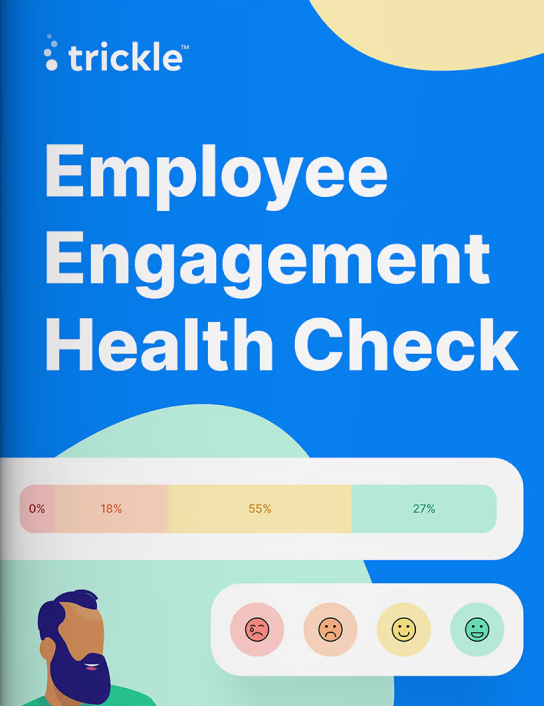How well does your company engage its employees?
Take your health check and find out.


Originally published on 27th April 2023, updated on 1st October 2024.
Employee engagement can be challenging – some people love to engage from the offset whilst others may be hesitant or avoid it altogether. According to Gallup’s recent report, in a list of 38 European countries, the UK ranked 33rd for employee engagement, with only 10% of employees feeling actively engaged at work, suggesting this is a significant challenge. In this article, we share six actionable methods for boosting employee engagement in your organisation.
William Kahn first coined the term employee engagement in the 1990s when it emerged as a new management hot topic. He defined it as “the harnessing of organisation members’ selves to their work roles; in engagement, people employ and express themselves physically, cognitively, and emotionally during role performances”.
Since then, the concept has become a key element of HR agendas across the globe.
These terms have become interchangeable in recent years as they’ve grown in popularity. However, employee participation and engagement are different. We think Total Wellness Health sums this up well:
“The difference between employee engagement and participation is an employee’s mindset. Participation is simply taking action, while engagement is making an investment.”
Employee participation is likely to be someone who will take part (e.g. by signing up to an initiative) but are only likely to put in minimal effort or focus. However, employee engagement goes significantly beyond this as the employee is likely to fully invest their time and energy to get the most out of their workplace. They’re likely to take part in optional and extra activities and if they experience positive results, they’re inclined to consider how they can elevate other aspects of their lifestyle outside of the workplace.
CIPD highlights numerous benefits of employee engagement, noting that when employees feel engaged at work, they are not only healthier, happier and more motivated on a personal level, but business performance can also improve. Research further supports this, showing strong correlations between positive employee engagement and key business metrics such as productivity, greater innovation and increased staff retention.
*It’s important to highlight that boosting employee engagement is a process; therefore, it could take time to see results.
The first stage in boosting employee engagement is ensuring key stakeholders understand the difference between employee participation, engagement and the key benefits. Once conversations with stakeholders begin, it might be useful to understand current engagement levels to pinpoint the scale of the project. Throughout this process, it might be useful to regularly check in with stakeholders particularly as they may offer varied insights, observations or perceptions.
Reviewing your organisation’s communication methods is crucial to identify what’s effective and where improvements can be made. While inviting feedback is valuable, it’s important to consider how feedback is collected and whether employees feel psychologically safe to speak openly and honestly. Providing an option for anonymous feedback could encourage more honest input.
Once feedback is collated, create a plan with relevant stakeholders to understand how people communicate in the workplace. For example, here at Trickle, we use our own Trickle platform internally – just as our customers would – to collect feedback, giving individuals the choice to share feedback either named or anonymously.
With any communication project it’s important to keep your people in the loop from day one so they understand what’s going on, which in-turn can encourage engagement over time. When communicating with people, don’t be afraid to ask people to get involved – either for their thoughts on how to make things better or feedback on an idea. Internally at Trickle, we practise ‘active listening’, which involves fully understanding and engaging what is actually being said.
With 69% of employees likely to stay with an organisation for three years if they’ve experienced great onboarding, it’s also important to consider future team members. Inspire and motivate them to engage from day one by introducing them to your organisation’s two-way communication culture. When someone joins the team, notify your colleagues and invite them to say hello to your new recruit. Facilitating conversations across departments can help new employees feel more comfortable and engaged.
As well as asking for feedback throughout the process, host dedicated sessions where people can find out more about an idea and have a space to share their thoughts and feedback.
It’s important to encourage participation from both leaders and wider teams — especially when it comes to implementing new processes or procedures. Whilst hosting workshops can seem like safe, welcoming spaces, you should also consider how people can get in touch with you afterwards if they don’t feel comfortable speaking up in the session. For example, how can they share their thoughts with you anonymously?
Organisations always want to keep their customers up-to-date, so, when it comes to employee engagement, it’s paramount to communicate with employees. For example, you might have an update that impacts everyone in the organisation or good news to share about an upcoming project or team. When giving updates, it’s useful to reassure people that they can ask questions at any point.
You might want to go further by identifying team members who are proactive about improving their working culture and harness their enthusiasm to launch positive, community-building initiatives that encourage other employees to participate.
Recognising when employees help the business reach its goals will reinforce its commitment to your vision and mission. Give leaders and colleagues a centralised spot to share company-wide kudos, peer nominations, and promotions.
For example, Trickle has a simple tool called Shout Abouts which is a fun and quick way to share company-wide news and keep people in the loop.
Want to find out more about how Trickle can help your organisation improve employee engagement? Click to learn more about our Features.